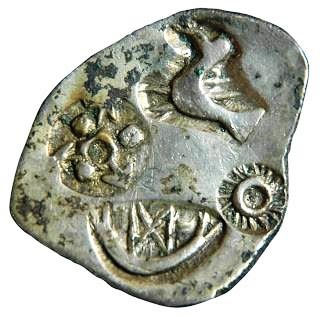The roots of Bangladesh's history are situated in the old river of Brahmaputra, in Narsingdi's Wari Bateshwar.
According to the archaeological evidence found in the Wari-Bateshwar Narsingdi region in 2006, settlements in Bangladesh developed almost 4 thousand years ago. Historical conceptions and recent archaeological discoveries discovered in Wari-Bateshwar had revealed that human settlement began in the region when the beginning of the Neolithic era began.
Wari Bateshwar: The Roots Of Bangladesh
The initial study of the land-based archaeology of Uari Botessor which purely tried old methods sought to create past settlement and cultural history.
 |
| a hoard of silver punch-marked coins |
The tool found in Wari-Bateshwar was given the opinion of the old and the new Stone Age era. But recently, the excavations of Wari-Bateshwar have evidently been discovered in the copper-stone era, due to the finding of houses and black warehouses by digging in the ground, it has been proved that there was a human habitation in the copper-stone era.
A large number of fossils, wood-built prehistoric base-lets, and hand-axes were found in this region; by looking at the type and shape of the tools, it can be assumed that the first human settlement was developed here during the Neolithic era.
A large number of fossils, wood-built prehistoric base-lets, and hand-axes were found in this region; by looking at the type and shape of the tools, it can be assumed that the first human settlement was developed here during the Neolithic era.
The archaeological site is so far the most ancient site of Bangladesh. Wari-Bateshwar, located in Belabo Upazila of Narsingdi district, 70 kilometers northeast of Dhaka, is about 2,500 years old.
In the context of the radiocarbon-14 test of some artifacts discovered in 2000, the town of Wari was confirmed as 450 BC. Wari and Bateswar villages have long been known as the founders of two shaded silver coins.
In the context of the radiocarbon-14 test of some artifacts discovered in 2000, the town of Wari was confirmed as 450 BC. Wari and Bateswar villages have long been known as the founders of two shaded silver coins.
 |
| silver punch marked coin |
The fortress of two and a half thousand years, located in the Pleistocene era, on the eastern border of Madhupur, has been discovered by intensive research and limited archaeological excavation. It is also seen in settlement of Mahasthan and Allahabad region of Uttar Pradesh, an ideal scheme and intellectual identity such as people living in high places.
The Fort is said to be the city in the Kautilya Arthashastra. Gordon Child explains the information of the ten controllers in rural areas in the towns and supports the same view. It was a fort, city or a city center developed in this process. An analysis of the discovered artifacts, however, shows that Wari Bateshwar was once a city and a flourishing business center.
 |
| A team of archaeology department of Jahangirnagar University with Professor Sufi Mostafizur Rahman |
A team of archaeology department of Jahangirnagar University with the help of local schoolteacher Habibullah Pathan, have discovered significant artifacts such as prehistoric tools, northern black polished ware (NBPW), architecture, semi-precious stone beads, ornaments, coins, iron tools, etc.
The site is a unique significance in the history of Bangladesh. It is located in the old Brahmaputra river basin, was a river port and international commercial center.
The site is a unique significance in the history of Bangladesh. It is located in the old Brahmaputra river basin, was a river port and international commercial center.
 |
| soil test |
It is believed that wari bateshwar is Ptolemy depicting ancient Sounagara. Many cities of the early-historic Indian subcontinent and the contact with Southeast Asia and the Mediterranean region were related to Wari-Bateshwar.
It was also connected with the 4,000-kilometer long silk route in 2300 years ago, has recently started to brighten up with a variety of evidence. According to historians, the settlement began in the region from the ancient times of civilization in Bangladesh.
In the pre-Buddhist era, there were many Parganas, canals, and jungle in Maheshwari Pargana and adjoining areas.
The people were very less in number. Occasionally there were houses of the non-Muslim people like Kirat, Tippai, Doi, Kabru, Garo, etc., evidence of the existence of human habitation in some parts of Bangladesh has been found from prehistoric times, and survival as a distinct and distinguished culture was a period.
According to the scholars-archaeologist-anthropologist researcher, the location of this region since the hemisphere.
It was also connected with the 4,000-kilometer long silk route in 2300 years ago, has recently started to brighten up with a variety of evidence. According to historians, the settlement began in the region from the ancient times of civilization in Bangladesh.
In the pre-Buddhist era, there were many Parganas, canals, and jungle in Maheshwari Pargana and adjoining areas.
The people were very less in number. Occasionally there were houses of the non-Muslim people like Kirat, Tippai, Doi, Kabru, Garo, etc., evidence of the existence of human habitation in some parts of Bangladesh has been found from prehistoric times, and survival as a distinct and distinguished culture was a period.
According to the scholars-archaeologist-anthropologist researcher, the location of this region since the hemisphere.
 |
| pit dwelling |
It is estimated that the ancient period of Bengal was in the territory of the Ganges, in the south and north 24 Parganas of present-day West Bengal, Hooghly, Howrah and Medinipur districts and boundaries of some parts of Burdwan district and present in the Padma (present-day Padma, Brahmaputra and Meghna) That is, the coastal areas of Bangladesh were in the region of the Ganges people.
It is said that the capital of the Gangaridhdhi was the Ganges. Gange was the commercial center. All researchers agree that the Wari Bateshwar was the ancient port and business center. In that case, it can be assumed that the site was the capital of Gange was the commercial center.
It is said that the capital of the Gangaridhdhi was the Ganges. Gange was the commercial center. All researchers agree that the Wari Bateshwar was the ancient port and business center. In that case, it can be assumed that the site was the capital of Gange was the commercial center.
It has been discovered from 50 archaeological sites in the Uari Botessor region, the stone and stone fossils of the prehistoric era- wood tools, the holes of the copper-colored culture- the settlement and the important new references to the history of Bangladesh are significant.
Wari-Bateshwar was the oldest city in Bangladesh. The Fort was the capital of these large populations. It was developed well-planned. In the meantime, the unique architectural features of the brick built along the castle-walled walls, trenches, paved roads, side roads, have been discovered from here.
Wari-Bateshwar was the oldest city in Bangladesh. The Fort was the capital of these large populations. It was developed well-planned. In the meantime, the unique architectural features of the brick built along the castle-walled walls, trenches, paved roads, side roads, have been discovered from here.
Recent archaeological excavation on the site, Fort, pit dwelling, settlements, ovens, and wells was found along with Krishna and pottery ware. Besides, the holes found in human habitation have been found in the particular type of stone. These are all evidence of rural settlement in the past copper-stone era in this region.
Wari Bateswar region had knowledge of the measurement of the people. They had ideas about geometry and trigonometry. After several recent archaeological excavations in this area Jasper, granite, crystal, other stone and terracotta bat-Khara have been discovered. Uari botessor was a trade center. It was grown in the factories, and perhaps they were exported to various places in Southeast Asia.
Wari Bateswar region had knowledge of the measurement of the people. They had ideas about geometry and trigonometry. After several recent archaeological excavations in this area Jasper, granite, crystal, other stone and terracotta bat-Khara have been discovered. Uari botessor was a trade center. It was grown in the factories, and perhaps they were exported to various places in Southeast Asia.
It was a city. Numerous punch-marked silver coins found in Wari Bateshwar. In the ancient era, for the practical need of business- trade, there was a need for a particular standard in the Wari-Bateshwar region; it is thought that some of these may have been used for measuring beetles.
 |
| semi-precious stone beads |
Approximately two and a half thousand years ago, the use of buttermilk of measurable stones such as Jasper, granite, crystal, etc. carried the identity of an advanced civilization in the Wari-Bateshwar region.
According to historians, the oldest coin-based economy of the subcontinent was developed in Narsingdi region. The archaeological remains of this area, which is a prosperous city and international trade center, was discovered in Wari Bateshwar, a pseudo-silver bank, Batakhara, which is a burning proof.
According to historians, the oldest coin-based economy of the subcontinent was developed in Narsingdi region. The archaeological remains of this area, which is a prosperous city and international trade center, was discovered in Wari Bateshwar, a pseudo-silver bank, Batakhara, which is a burning proof.
From terracotta figurines, it can be assumed that there were the circulation and use of iron smelting technology at high temperatures. The religious nature of the Uari botessor archaeological site is not known. But the pottery obtained at the location is indicative of Buddhist culture in this region.
 |
| stone tool |
Professor Dilip Kumar Chakrabarty of the South Asian Archeology Department at Cambridge University thinks that the contact with Wari-Bateshwar was in touch with Southeast Asia and the Roman Empire. Because of all the materials available in rouletted ware, sandwich glass beads, gold-covered glass beads; Tin mixed bronze, etc. prove this information.
Since the formation of a well-organized state system, the region is making a significant contribution to the state economy as a primary economic unit, and this trend is still going on.
Narsingdi has a golden history of two and a half thousand years old textile industry, which is still a legend in the history of the entire civilization of the whole world. Suvarna village's cotton cloth spreads its reputation all over the world, because of better excellence than the delicate fabrics made of Mathura, Banarasi, and Ujjain in India.
Narsingdi has a golden history of two and a half thousand years old textile industry, which is still a legend in the history of the entire civilization of the whole world. Suvarna village's cotton cloth spreads its reputation all over the world, because of better excellence than the delicate fabrics made of Mathura, Banarasi, and Ujjain in India.
 |
| terracotta |
Based on the archaeological sites discovered in Narsingdi district, it is possible that a thousand years ago, in the eastern part of Bangladesh, the primitive people started a permanent social life and formed the basis of the social system in the northern highlands of Narsingdi district.
In recent years so many archaeological remains found on the bank of Arial Kha and Paharia river of Narsingdi district. Based on these patterns, the population of this region is estimated to be around ten thousand to ten lac years ago.
In recent years so many archaeological remains found on the bank of Arial Kha and Paharia river of Narsingdi district. Based on these patterns, the population of this region is estimated to be around ten thousand to ten lac years ago.
 |
| Habibullah Pathan Sir |
In the 1930s, Muhammad Hanif Pathan, the school teacher, first highlighted the archaeological importance of the site. Later, his son Muhammad Habibullah Pathan started collecting and researching the site.
After a long time since 1996, an archaeological survey was done in the Wari Bateshwar region and since 2000; regular archaeological excavation began. When analyzing all the artifacts found in Wari Bateshwar, there is clear evidence of the settlement stone age, the Neolithic era, the early historic era and historical settlement in the region.
After a long time since 1996, an archaeological survey was done in the Wari Bateshwar region and since 2000; regular archaeological excavation began. When analyzing all the artifacts found in Wari Bateshwar, there is clear evidence of the settlement stone age, the Neolithic era, the early historic era and historical settlement in the region.









This comment has been removed by the author.
ReplyDeleteI have worked there as a research assistant as I was a student of Archaeology department of Jahangirnagar university. It was my great pleasure to work there with Dr. Sufi Mostafizur Rahman and Habibullah Pathan sir as well.
ReplyDeleteWow this looks like such an amazing place to visit and view this s wonderful history!!! Shell
ReplyDeleteMany many thanks Anonymous for your valuable comment.
DeleteWhat a great post. I totally learned so much from this!
ReplyDeleteVery happy that you loved the post.
DeleteSuch a great presentation! Never thought that this place would had so many years of history.
ReplyDeleteHello Helene, thanks for your inspiring comment.
DeleteMy major in college was anthropology so I really loved reading this! Thank you this was very informative and interesting and well written!
ReplyDeleteSo, you are an anthropologist, many thanks for your valuable comment.
DeleteI liked this post. Havent been to Bangaladesh but this post gave me a thought to visit these sites.
ReplyDeleteGreat, visit Bangladesh. Our country is really very beautiful. Amar Sonar Bangla.
DeleteVery informative :) Thank you for sharing the richness of history
ReplyDeleteSuch a wonderful post full so much information, thank you so much for sharing!!
ReplyDeleteWOW! Amazing historical artifacts they have found in Bangladesh! Seriously having a India travel bug right now!
ReplyDeleteArchaeology has always been fascinating to me, it is so amazing that places like this one still exists! We still have so much to learn about our past, thank you for sharing!
ReplyDeleteI love looking for activities like this. I like to learn something new about other things.
ReplyDeleteI got an awesome history lesson today from reading this. I must admit I did not know much about Bangaladesh. I have traveled the world extensively while serving in the Army but this truly have me intrigued.
ReplyDeleteThanks for sharing.
Wonderful guide, Historical picture and place.
ReplyDeleteAndroid Oreo
great post i have learnt from it
ReplyDeleteNICE POST HISTORICAL CONTENT
ReplyDeleteThanks for your valuable comment
Deletevery historical, great research, thanks for sharing your history
ReplyDeleteYeah, Wari-Bateshwar is an important historical places in Bangladesh. I have worked there as a research assistant.
Deleteseeing places like this makes my heart happy. It is so interesting to see things like this.
ReplyDeleteThank you so much Kristal Xavier.
DeleteVery interesting, thank you for sharing! What an amazing experience this must have been to enjoy in person! :)
ReplyDeleteInteresting post. Sounds like a beautiful place to visit.
ReplyDeleteWow, I am so interested about the silver punched coins. I wonder what the differences were in the values of them!
ReplyDeleteThis is so interesting. It will be a pleasure to get more info on this topic. It is interesting to see what really out there.
ReplyDeleteAbsolutely incredible. I'm crazy about historical everything. So cool!
ReplyDeleteThis is incredible. Like looking into the past. When you say they discovered "a pseudo-silver bank" do you mean they found tons of those silver coins?
ReplyDeleteIt is very interesting to read, and very curious to see such existing places which holds the history of ancients. Good to seethe historical artifacts. Thanks for sharing..!
ReplyDeleteI haven't seen much about Bangladesh for a pretty long time. I had some high school & college friends from bangladesh.
ReplyDelete